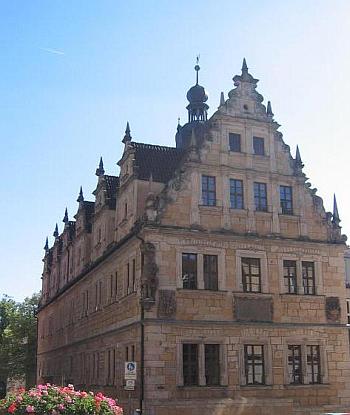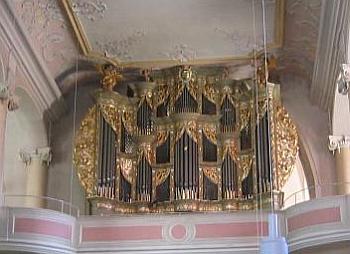Coburg, birthplace of Felix Draeseke
Although located near the geographic center of a unified Germany, Coburg remains relatively off most traveled roads. Despite its attractions and small-town charm, overseas tourists are still rather scarce and it qualifies as a "Hidden Treasure." Originally a ducal town of Upper Franconia, the city was transferred to Bavaria only in 1920 after a local referendum. After the Second World War, while the rest of Saxon-Thuringian territory was incorporated into the German Democratic Republic, "Bavarian" Coburg became part of West Germany. As a result, the city spent the Cold War years lying right next to the Iron Curtain, surrounded by East Germany on three sides. |
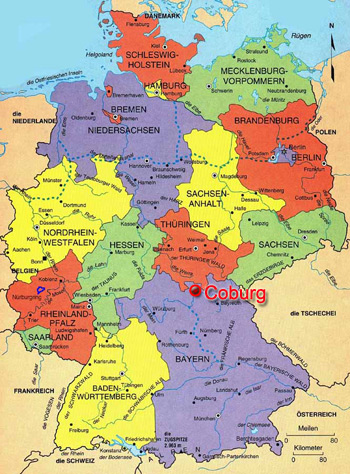 |
At the center of town, Coburg's Marktplatz is a perfect place to try Coburg's signature "fast food" the Coburger Bratwurst - a sausage roasted over a pinecone fire. Stands set up shop at several locations on the square and dense smoke is often visible during daylight hours at the Marktplatz webcam. The official length of the sausage is dictated by the Bratwurstmännle atop the Rathaus. |
|
Coburg Marktplatz: Coburg Stadthaus (Town House; legislative building). At the north side of the square stands the impressive Stadthaus, originally built in ca. 1600.
|
|
On the west side of the Coburg Marktplatz stands house number 9, Draeseke's Birthplace. Note the plaque at the building's center. The building was acquired in the late 19th Century by the historic Coburg book firm, Buchhandlung Riemann. Original photograph from the wikimedia site. |
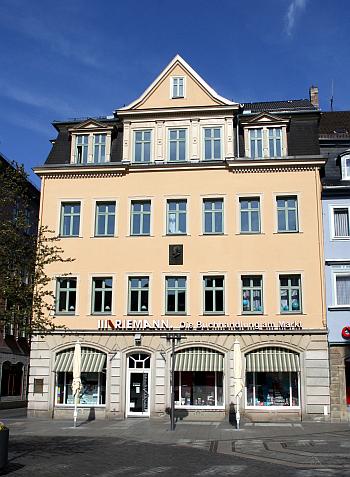 |
Coburg Marktplatz, view to the west: Marktplatz 9 is at the far right. Original photograph from the wikimedia site. |
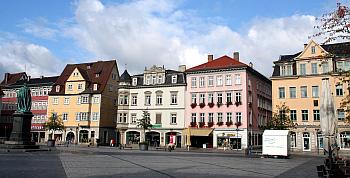 |
Coburg Marktplatz: Marktplatz 9 (Draeseke's Birthplace [detail of commemorative plaque]). The plaque was designed and executed by the sculptor Edmund Meusel (1876-1960) in commemoration of the 100th anniversary of Draeseke's birth. |
|
Coburg Marktplatz via live webcam! The webcam view is to the north (the Stadthaus is the large building behind the square). Marktplatz 9, Draeseke's birthplace, is at the far left in this live webcam view from atop the Rathaus. |
 |
Coburg Marktplatz: Coburg Rathaus (Town Hall). At the south side of the Marktplatz square stands the impressive Rathaus, originally from the 15th Century. Johann Strauss Jr., the Viennese Waltz King, became a Coburg citizen due to the circumstances surrounding his second marriage, conducted at the Coburg Rathaus. |
|
Coburg Marktplatz: Coburg Rathaus (Town Hall). The statue of the Bratwurstmännle - who holds the Coburg equivalent of the original meter in Paris - is located over the ornate central triangular peak. The Marktplatz webcam is located on the second floor of the Rathaus. |
|
|
The Landestheater was the location of many performances of Draeseke's music including several premieres. The theater dates from 1838 and was designed by Carl Balthasar Harres, a student of Karl Friedrich Schinkel.
|
|
|
View from the north. Starting in the mid 16th century, the dukes of Saxe-Coburg-Gotha lived in the Ehrenburg Castle, in the city of Coburg itself. Once purely done in the Renaissance style, the building was rebuilt largely in a neo-Gothic style in the 19th century, following a fire. |
|
|
View from the south. The interior of Schloss Ehrenburg, is in an elegant French Empire style. An interesting anecdote is that the castle's flush toilet, allegedly the first ever in continental Europe, was installed in time for a visit from Queen Victoria in 1860. |
|
|
Draeseke performances in the Ehrenburg Castle (2005). Click to see and hear an excerpt.
|
|
The medieval Veste Coburg, one of the biggest and most beautiful castles in Germany. Located on a hill overlooking the town, the Veste-Coburg fortress dominates Coburg, and can be seen from almost every street. It looks fantastic, especially when lit up at night, and makes for a pleasant, if slightly exhausting, walk. It also offers great views of the town and surrounding countryside. The fortress is one of the best preserved in Germany, and has an impressive history. |
|
|
It was mostly rebuilt in the 19th century. It has a triple line of walls with numerous towers. Martin Luther resided here in 1530. The edifices contain today 3 museums with armories, art galleries, exhibitions and other attractions. |
|
The Gymnasium Casimirianum Coburg. In 1848 Draeseke entered this prestigious school for completion of his secondary education and where he begins to seriously study music. |
|
The Gymnasium Casimirianum Coburg; entrance. The school is located at Gymnasiumsgasse 2-4, |
|
|
The Moriz church is the main church in the Protestant parish St. Moriz. The building history of today's Moriz church dates back to the 14th century. Saint Moriz (Saint Mauritius) is the patron saint of Coburg.
|
|
Coburg: Morizkirche organ The church's Schuke organ dates from 1740 and was restored in 1989. The Morizkirche was site of many concerts of music of Felix Draeseke, including not only organ music, but also the premiere of his Symphonic Andante for Violoncello Solo and Orchestra. |
|
Coburg: Spitaltor The boundaries of Coburg's Altstadt are still easily discernible, thanks to the survival of three now disembodied gateways. Crowned with an onion dome, the Spitaltor at the junction of Spitalgasse and Georgengasse served as the northern entrance to town. View of Spitaltor from the north. |
|
Coburg: Ketschentor The boundaries of Coburg's Altstadt are still easily discernible, thanks to the survival of three now disembodied gateways. The Ketschentor on Ketschengasse was the entrance from the western and southern areas. The Ketschentor, viewed from the south side. |
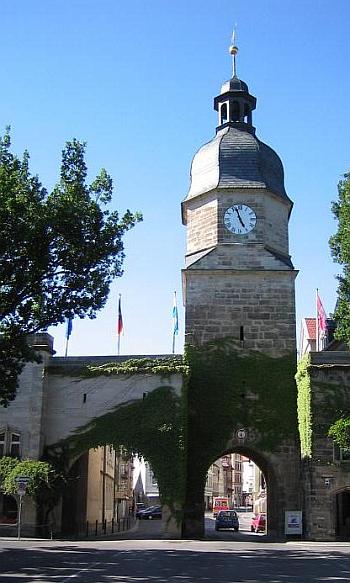 |
Coburg resources: |
|
[Chamber Music] [Orchestral Music] [Keyboard Music] [Music Samples] [Top]
© All contents copyright by the International Draeseke Society
